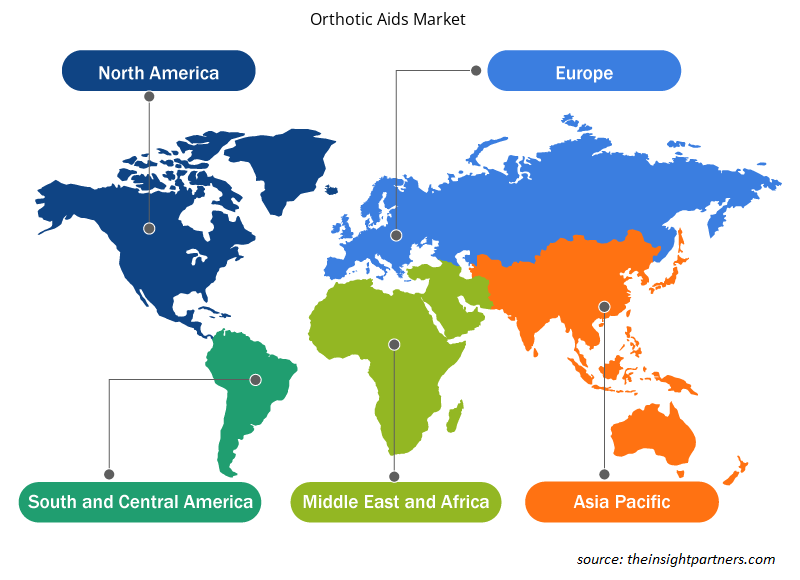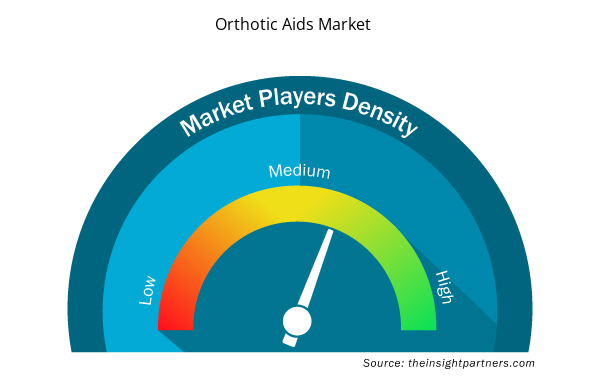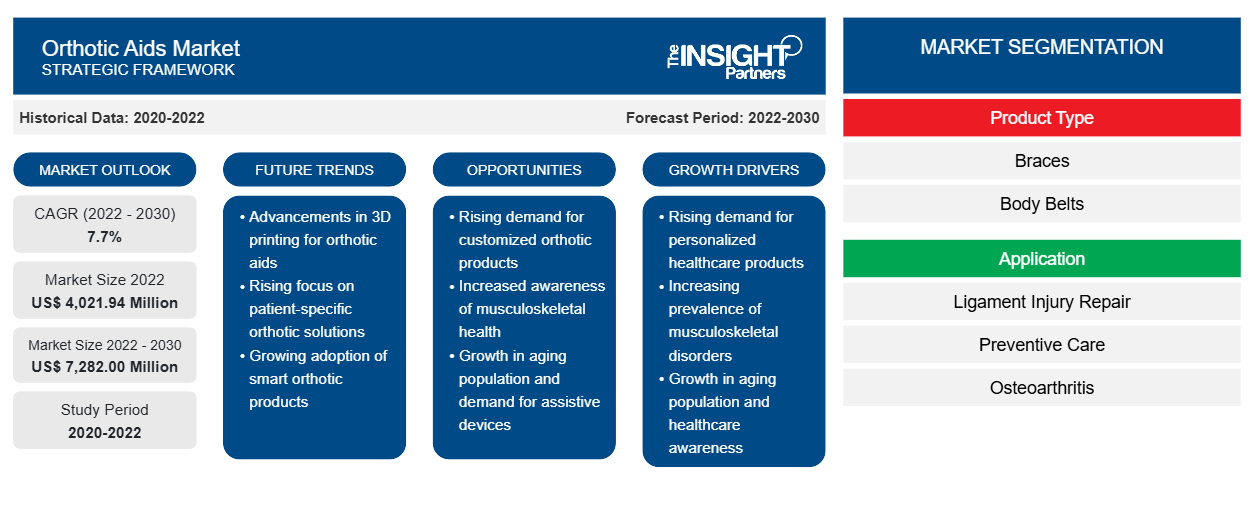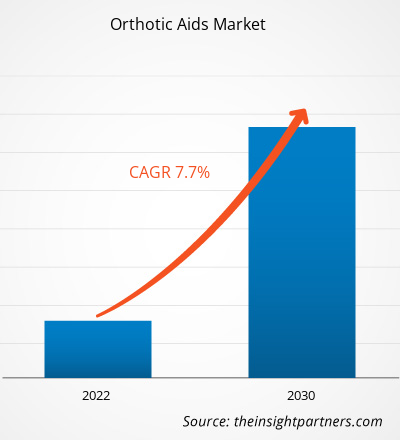[研究报告] 矫形辅助器市场规模预计将从 2022 年的 40.2194 亿美元增长到 2030 年的 72.82 亿美元;预计该市场在 2022-2030 年期间的复合年增长率为 7.7%。
市场洞察和分析师观点:
矫形辅助器具用于为肌肉骨骼系统提供支撑和稳定性;预防、矫正或调整畸形;以及改善身体部位的功能。一些常用的矫形辅助器具包括足部矫形器、膝盖支架、背部支架、腕部支架和踝部支架。全球大量人口的骨科疾病激增,增加了对矫形辅助器具的需求。此外,矫形器市场参与者不断增加的产品发布、技术进步和战略合作可能会在未来几年扩大矫形辅助器具市场的增长。
增长动力:
身体带和支架等矫形辅助器有助于脑瘫、脑损伤、脊髓损伤和其他神经/矫形疾病患者活动和支撑。根据美国疾病控制和预防中心的数据,2020 年美国报告了约 214,110 例创伤性脑损伤 (TBI) 相关住院病例和 69,473 例 TBI 相关死亡病例。因此,随着患有各种矫形和神经疾病的患者数量的增加,矫形辅助器的使用也在增加。
医疗设施的现代化和医疗服务的改善最终提高了人们的预期寿命,导致全球老年人口增加。老年人跌倒的风险更大,由于肌肉和骨骼会随着年龄的增长而磨损,轻微的事故也可能导致骨折或骨折。骨质疏松症和其他可能影响老年人的疾病可能会进一步增加骨折的风险。因此,老年人口的激增与骨科损伤和疾病数量的激增有关,从而产生了对矫形辅助器具的需求。根据骨关节炎 (OA) 行动联盟的数据,在美国,88% 的 OA 患者年龄至少为 45 岁,43% 的 OA 患者年龄在 65 岁或以上。
由于骨科和神经肌肉疾病(如脑瘫、脊柱裂、肌营养不良症和马蹄足)的影响,儿童的肌肉骨骼系统可能会以某种方式发育,导致运动和姿势困难。根据美国疾病控制和流行中心 (CDC) 的数据,马蹄足是美国最常见的先天性残疾之一,2022 年美国约有 6,643 名婴儿患有该疾病。儿科支撑涉及使用专门的矫形器或支架来支撑和调整儿童身体的关节,特别是脊柱、臀部、膝盖、脚踝和脚部的关节。这些设备是在诊断后开具的,通常是根据患者的需求制造的。
因此,各个年龄段的人群中矫形辅助器的使用增加推动了矫形辅助器市场的增长。
保险覆盖不一致或产品覆盖有限会导致患者的成本负担增加。矫形治疗和辅助器具的高成本以及不利的报销政策阻碍了矫形器具市场的增长。患有慢性疼痛或受伤的老年人可以从背部支架中受益匪浅。耐用的手臂、腿部、颈部和背部支架由医疗保险 B 部分承保,但有一些限制。医疗保险支架福利涵盖膝关节矫形器。矫形器必须是半刚性或刚性装置,用于支撑虚弱或变形的身体部位,或限制或完全排除患病或受伤的身体部位的运动,才有资格获得此福利的承保。支架福利的法定定义不适用于那些不够坚硬而无法固定或支撑其预期使用的身体部位的物品。不符合支架描述的物品不在承保范围内,也不符合此医疗保险福利的福利条件。
定制此报告以满足您的需求
您可以免费定制任何报告,包括本报告的部分内容、国家级分析、Excel 数据包,以及为初创企业和大学提供优惠和折扣
- 获取此报告的关键市场趋势。这个免费样品将包括数据分析,从市场趋势到估计和预测。
报告细分和范围:
“矫形辅助器市场”根据产品类型、应用、分销渠道、供应商类型和地理位置进行细分。根据产品类型,矫形辅助器市场细分为支架、身体带和其他。在应用方面,矫形辅助器市场细分为韧带损伤修复、预防保健、骨关节炎、压迫疗法和其他。根据分销渠道,市场分为线上和线下。根据供应商类型,矫形辅助器市场分为品牌和非品牌。根据地理位置,矫形辅助器市场分为北美(美国、加拿大、墨西哥)、欧洲(德国、英国、法国、意大利、西班牙、欧洲其他地区)、亚太地区(中国、日本、印度、澳大利亚、韩国、亚太其他地区)、中东和非洲(沙特阿拉伯、南非、阿联酋和 MEA 其他地区)以及南美洲和中美洲(巴西、阿根廷、南美洲和中美洲其他地区)。
节段分析:
按照产品类型,矫形辅助器具市场可分为支架、身体带和其他。支架部分在 2022 年占据了最大的市场份额。预计同一部分在 2022-2030 年期间的复合年增长率最高。背部牵引带、弹性背部支架、铜带、背痛带和背部支架等身体带通常用于治疗关节扭伤、肌肉拉伤和损伤。大多数人一生中都可能经历背痛。虽然受伤和疾病是背痛的几种原因之一,但很大一部分病例是由于不正确举起重物和姿势不良造成的。佩戴背部支架是预防背痛和改善姿势的常用方法。根据 Cross River Therapy 的数据,10 个美国人中有 8 个报告称一年内至少出现一次或多次背部问题。根据同一来源,8000 万工人(占所有就业美国人的 50%)每年报告背痛。
根据应用,矫形辅助器市场细分为韧带损伤修复、预防护理、骨关节炎、压迫疗法等。韧带损伤修复部分在 2022 年占据最大市场份额,预计 2022-2030 年复合年增长率最高。内侧副韧带 (MCL)、后交叉韧带 (PCL)、前交叉韧带 (ACL) 和外侧副韧带 (LCL) 是膝盖中的四条主要韧带。韧带对于保持膝盖活动至关重要,轻微的损伤也会给人带来很大的不适。膝关节支架可以减轻膝盖的负荷。如果出现部分撕裂,医生可能会建议使用 ACL 支架和物理疗法进行非手术修复 ACL 撕裂以增强肌肉。然而,对于接受手术的患者,医生建议佩戴术后护膝和拐杖,直到伤口完全愈合。ACL 撕裂的康复过程相对较长,可能需要 6 个月到 1 年才能完成。康复后,医生可能会建议患者在运动时佩戴 ACL 护膝。
PCL 撕裂分为四类:1 级撕裂、2 级撕裂、3 级撕裂和健康 PCL。如果撕裂严重,患者可能需要接受 PCL 手术。手术后,建议患者佩戴 PCL 护膝以进行术后恢复。Brace Ability 提供多种护具和支撑物,用于预防和治疗 PCL 撕裂。大多数 MCL 损伤可以在家中通过冰敷、消炎药物和休息进行治疗。医生可能会建议佩戴有助于保护患者膝盖并允许一定活动范围的护具。如果撕裂非常严重,患者可能需要手术。
根据分销渠道,矫形辅助器市场分为线上和线下。线下市场在 2022 年占据了更大的市场份额。然而,预计线上市场在 2022-2030 年期间的复合年增长率会更高。在线药店允许客户购买处方药、医疗设备和电子服务,而无需前往实体店,使他们能够在家中快速舒适地获得药物或服务。互联网普及、数字化、政府支持、经济蓬勃发展等是促成矫形辅助器市场通过在线分销渠道增长的主要因素。例如,沃尔玛和 Medical Department Store, Inc. 是提供支架、身体带、臂带等的少数在线分销商。
根据供应商类型,矫形辅助器市场分为品牌和非品牌。品牌部分在 2022 年占据了更大的市场份额;然而,预计非品牌部分在 2022-2030 年期间的复合年增长率会更高。品牌矫形辅助器包括由在全球具有重要影响力的知名制造商生产的产品;这些产品通过线上和线下分销渠道提供。美国是全球第二大护膝进口国,其大部分护膝来自中国、越南和比利时。发展中经济体制造商数量有限,消费者购买力不断提高,这鼓励品牌商品制造商提供满足不断变化的消费者需求的产品。
区域分析:
全球矫形辅助器市场分为北美、欧洲、亚太地区、中东和非洲以及南美和中美。由于骨科疾病在大量人口中患病率不断上升,以及易患此类疾病的老年人口数量激增,北美预计将占据主要市场份额。此外,产品发布、地域扩张和技术进步预计将在未来推动该地区矫形辅助器市场的增长。北美矫形辅助器市场分为美国、加拿大和墨西哥。美国占据主要市场份额。骨关节炎行动联盟 (OAAA) 指出,关节炎是美国的一个严重健康危机。根据美国疾病控制与预防中心 (CDC) 的估计,2019-2021 年期间,美国有 5320 万成年人(即约 25% 或四分之一的人)患有某种形式的关节炎,预计到 2040 年这一数字将达到 7800 万。关节炎和相关疾病有 100 多种形式。骨关节炎 (OA) 患者比同龄人经历更严重的疼痛、致残、疲劳和活动受限。慢性和发作性疼痛可导致功能障碍和工作受限。关节炎的特征是一个或多个关节压痛和肿胀。关节炎的主要症状包括僵硬和关节疼痛,通常会随着年龄的增长而恶化。矫形辅助器具(如膝关节支架)可以帮助缓解疼痛,并在不使用药物的情况下为关节或身体部位提供保护和支撑。背部支架可增强肌肉和上身力量,从而降低骨质疏松性骨折的风险。
美国脊髓损伤发病率的不断上升推动了矫形辅助器具市场的发展。根据美国神经外科医师协会的数据,美国每年有近 17,000 例新的脊髓损伤病例。美国国家多发性硬化症协会表示,2020 年美国约有 100 万人患有多发性硬化症。因此,脊髓损伤和多发性硬化症导致的残疾需要矫形辅助器具来帮助这些患者实现活动。医生建议脊髓损伤 (SCI) 患者使用支架。支架从外部调整脊柱位置,在软组织(如韧带)无法稳定脊柱时稳定脊柱,施加矫正力并限制运动。
预计 2022-2030 年期间,亚太地区的矫形辅助器具市场将实现显著的复合年增长率。预计市场增长的原因是老年人口不断增加,老年人口易患各种骨科疾病。中国是老年人口最多的国家之一。根据 2023 年人口参考局的数据,到 2050 年,中国老年人口预计将达到 3.66 亿,大大超过美国。此外,市场参与者之间的合作、技术进步和产品发布将进一步推动亚太地区矫形辅助器具市场的增长。2023 年 1 月,Breg, Inc. 与医疗器械供应商 Coreal International 合作,将其广泛的支撑和冷疗产品组合带给中国医生及其患者。
矫形辅助器市场区域洞察
Insight Partners 的分析师已详尽解释了预测期内影响矫形辅助器市场的区域趋势和因素。本节还讨论了北美、欧洲、亚太地区、中东和非洲以及南美和中美洲的矫形辅助器市场细分和地理位置。

- 获取矫形辅助器具市场的区域特定数据
矫形辅助器具市场报告范围
| 报告属性 | 细节 |
|---|---|
| 2022 年市场规模 | 40.2194亿美元 |
| 2030 年市场规模 | 72.82 亿美元 |
| 全球复合年增长率(2022 - 2030 年) | 7.7% |
| 史料 | 2020-2022 |
| 预测期 | 2022-2030 |
| 涵盖的领域 | 按产品类型
|
| 覆盖地区和国家 | 北美
|
| 市场领导者和主要公司简介 |
|
市场参与者密度:了解其对商业动态的影响
矫形辅助器具市场正在快速增长,这得益于终端用户需求的不断增长,而这些需求又源于消费者偏好的不断变化、技术进步以及对产品优势的认识不断提高等因素。随着需求的增加,企业正在扩大其产品范围,进行创新以满足消费者的需求,并利用新兴趋势,从而进一步推动市场增长。
市场参与者密度是指在特定市场或行业内运营的企业或公司的分布情况。它表明在给定市场空间中,相对于其规模或总市场价值,有多少竞争对手(市场参与者)存在。
在矫形辅助器具市场运营的主要公司有:
- 奥索高频
- 奥托博克股份公司
- 瑞士苏黎世电信公司
- 菲劳尔有限责任公司
- Lohmann & Rauscher 有限公司
免责声明:上面列出的公司没有按照任何特定顺序排列。

- 了解矫形辅助器具市场的主要参与者概况
行业发展和未来机遇:
以下列出了矫形辅助器具市场的主要参与者采取的各种举措:
- 2023 年 10 月,OrthoPediatrics Corp. 推出了 DF2 支架,作为其非手术业务扩张的一部分。该产品适用于治疗患有肌肉骨骼损伤的儿童。该支架旨在取代 6 个月至 5 岁儿童患者股骨骨折固定中的人字形石膏,从而固定股骨、膝盖和髋部。
- 2021 年 2 月,Breg, Inc. 推出了两条新的脊柱矫形器系列:Pinnacle 和 Ascend。这两条产品线共包含 15 种产品,旨在提高脊柱损伤患者的护理水平。
竞争格局和重点公司:
Ossur hf、Ottobock SE & Co KGaA、Thuasne SAS、Fillauer LLC、Lohmann & Rauscher GmbH & Co KG、DeRoyal Industries Inc、Hanger Inc、Steeper Group Holdings Ltd、Breg Inc 和 DJO LLC 是知名的矫形辅助器具公司。这些公司专注于新技术、现有产品的改进和地域扩张,以满足全球日益增长的消费者需求。
- 历史分析(2 年)、基准年、预测(7 年)及复合年增长率
- PEST 和 SWOT 分析
- 市场规模价值/数量 - 全球、区域、国家
- 行业和竞争格局
- Excel 数据集



Report Coverage
Revenue forecast, Company Analysis, Industry landscape, Growth factors, and Trends

Segment Covered
This text is related
to segments covered.

Regional Scope
North America, Europe, Asia Pacific, Middle East & Africa, South & Central America

Country Scope
This text is related
to country scope.
常见问题
The devices or supports known as orthotic aids are intended to enhance the sustainability and functionality of various body parts, usually the musculoskeletal system. These tools are frequently employed to address problems like pain, damage, or deformity. Common orthotic aids include orthotic insoles, ankle braces, knee braces, back braces, wrist braces, shoulder braces, neck braces, prosthetic limbs, spinal orthoses, etc. Orthotic devices have been shown to reduce pain and enhance people's quality of life significantly.
The global orthotic aids market is analyzed based on product type, application, type of supplier, and distribution channel. Based on product type, braces segment dominates the market growth during 2022-2030.
The growth of the global orthotic aids market is attributed to a few key factors, such as increasing prevalence of orthopedic conditions among people of different age groups. Additionally, the rising number of strategic collaborations and product launches by market players is expected to contribute to the orthotic aids market proliferation in the future.
The global orthotic aids market segmented into North America, Europe, Asia Pacific, Middle East & Africa, and South & Central America. North America is expected to dominate the market in terms of market share however, Asia Pacific is expected to register the highest growth rate during 2022-2030.
The global orthotic aids market majorly consists of the players such as Ossur hf, Ottobock SE & Co KGaA, Thuasne SAS, Fillauer LLC, Lohmann & Rauscher GmbH & Co KG, DeRoyal Industries Inc, Hanger Inc, Steeper Group Holdings Ltd, Breg Inc, and DJO LLC.
Trends and growth analysis reports related to Life Sciences : READ MORE..
The List of Companies - Orthotic Aids Market
- Ossur hf
- Ottobock SE & Co KGaA
- Thuasne SAS
- Fillauer LLC
- Lohmann & Rauscher GmbH & Co KG
- DeRoyal Industries Inc
- Hanger Inc
- Steeper Group Holdings Ltd
- Breg Inc
- DJO LLC
The Insight Partners performs research in 4 major stages: Data Collection & Secondary Research, Primary Research, Data Analysis and Data Triangulation & Final Review.
- Data Collection and Secondary Research:
As a market research and consulting firm operating from a decade, we have published and advised several client across the globe. First step for any study will start with an assessment of currently available data and insights from existing reports. Further, historical and current market information is collected from Investor Presentations, Annual Reports, SEC Filings, etc., and other information related to company’s performance and market positioning are gathered from Paid Databases (Factiva, Hoovers, and Reuters) and various other publications available in public domain.
Several associations trade associates, technical forums, institutes, societies and organization are accessed to gain technical as well as market related insights through their publications such as research papers, blogs and press releases related to the studies are referred to get cues about the market. Further, white papers, journals, magazines, and other news articles published in last 3 years are scrutinized and analyzed to understand the current market trends.
- Primary Research:
The primarily interview analysis comprise of data obtained from industry participants interview and answers to survey questions gathered by in-house primary team.
For primary research, interviews are conducted with industry experts/CEOs/Marketing Managers/VPs/Subject Matter Experts from both demand and supply side to get a 360-degree view of the market. The primary team conducts several interviews based on the complexity of the markets to understand the various market trends and dynamics which makes research more credible and precise.
A typical research interview fulfils the following functions:
- Provides first-hand information on the market size, market trends, growth trends, competitive landscape, and outlook
- Validates and strengthens in-house secondary research findings
- Develops the analysis team’s expertise and market understanding
Primary research involves email interactions and telephone interviews for each market, category, segment, and sub-segment across geographies. The participants who typically take part in such a process include, but are not limited to:
- Industry participants: VPs, business development managers, market intelligence managers and national sales managers
- Outside experts: Valuation experts, research analysts and key opinion leaders specializing in the electronics and semiconductor industry.
Below is the breakup of our primary respondents by company, designation, and region:

Once we receive the confirmation from primary research sources or primary respondents, we finalize the base year market estimation and forecast the data as per the macroeconomic and microeconomic factors assessed during data collection.
- Data Analysis:
Once data is validated through both secondary as well as primary respondents, we finalize the market estimations by hypothesis formulation and factor analysis at regional and country level.
- Macro-Economic Factor Analysis:
We analyse macroeconomic indicators such the gross domestic product (GDP), increase in the demand for goods and services across industries, technological advancement, regional economic growth, governmental policies, the influence of COVID-19, PEST analysis, and other aspects. This analysis aids in setting benchmarks for various nations/regions and approximating market splits. Additionally, the general trend of the aforementioned components aid in determining the market's development possibilities.
- Country Level Data:
Various factors that are especially aligned to the country are taken into account to determine the market size for a certain area and country, including the presence of vendors, such as headquarters and offices, the country's GDP, demand patterns, and industry growth. To comprehend the market dynamics for the nation, a number of growth variables, inhibitors, application areas, and current market trends are researched. The aforementioned elements aid in determining the country's overall market's growth potential.
- Company Profile:
The “Table of Contents” is formulated by listing and analyzing more than 25 - 30 companies operating in the market ecosystem across geographies. However, we profile only 10 companies as a standard practice in our syndicate reports. These 10 companies comprise leading, emerging, and regional players. Nonetheless, our analysis is not restricted to the 10 listed companies, we also analyze other companies present in the market to develop a holistic view and understand the prevailing trends. The “Company Profiles” section in the report covers key facts, business description, products & services, financial information, SWOT analysis, and key developments. The financial information presented is extracted from the annual reports and official documents of the publicly listed companies. Upon collecting the information for the sections of respective companies, we verify them via various primary sources and then compile the data in respective company profiles. The company level information helps us in deriving the base number as well as in forecasting the market size.
- Developing Base Number:
Aggregation of sales statistics (2020-2022) and macro-economic factor, and other secondary and primary research insights are utilized to arrive at base number and related market shares for 2022. The data gaps are identified in this step and relevant market data is analyzed, collected from paid primary interviews or databases. On finalizing the base year market size, forecasts are developed on the basis of macro-economic, industry and market growth factors and company level analysis.
- Data Triangulation and Final Review:
The market findings and base year market size calculations are validated from supply as well as demand side. Demand side validations are based on macro-economic factor analysis and benchmarks for respective regions and countries. In case of supply side validations, revenues of major companies are estimated (in case not available) based on industry benchmark, approximate number of employees, product portfolio, and primary interviews revenues are gathered. Further revenue from target product/service segment is assessed to avoid overshooting of market statistics. In case of heavy deviations between supply and demand side values, all thes steps are repeated to achieve synchronization.
We follow an iterative model, wherein we share our research findings with Subject Matter Experts (SME’s) and Key Opinion Leaders (KOLs) until consensus view of the market is not formulated – this model negates any drastic deviation in the opinions of experts. Only validated and universally acceptable research findings are quoted in our reports.
We have important check points that we use to validate our research findings – which we call – data triangulation, where we validate the information, we generate from secondary sources with primary interviews and then we re-validate with our internal data bases and Subject matter experts. This comprehensive model enables us to deliver high quality, reliable data in shortest possible time.


 获取此报告的免费样本
获取此报告的免费样本